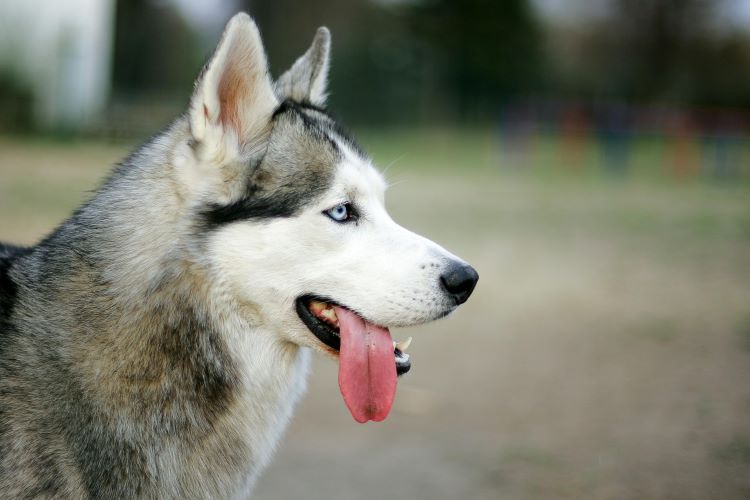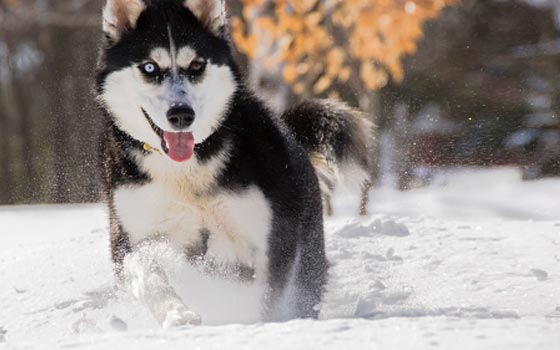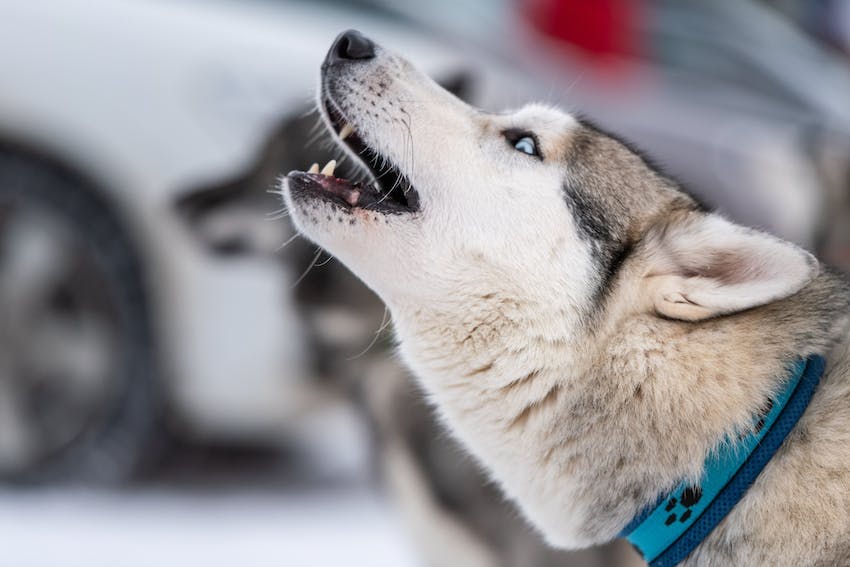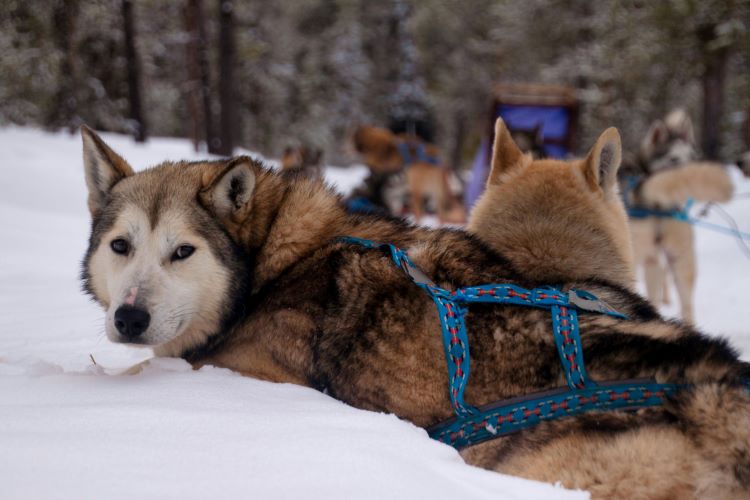Ready to help treat your pet to a healthy life?
The Siberian Husky: Fun Facts, History & Care Tips
By : Trupanion Staff | Updated Nov 5, 2024

A Husky is an intelligent and playful dog, with never-ending puppy energy and an eagerness for adventure. While not known for their guard dog skills because they’re so sociable, they are incredibly loyal to their family and love to be involved in everything. If you desire a high-energy companion, who will talk endlessly and throw you judgemental but loving looks every once in a while, the Siberian Husky may be a great choice.
Of course, it's a good idea to learn more about these dogs before deciding to adopt. Like all canine breeds, Siberian Huskies can make excellent companions but have specific needs that must be met. As pets, their endless energy and intelligence require daily physical and mental stimulation, or they may become frustrated and act out aggressively. They may go after small neighborhood animals, and caution should be taken with other household pets. Siberian Huskies can have unpredictable personalities, and children and strangers should be cautious when approaching them.
Ready to learn more about the Siberian? Whether you're considering adopting one of your own or just wanting to get to know these beautiful dogs, this guide has you covered.
10 fun facts about Siberian Huskies
- The Siberian Husky is an ancient breed developed by the Chukchi people of eastern Siberian, in an area known as the Chukotka Peninsula
- The Siberian Husky is the only dog breed kennel clubs like the AKC refer to as a "Husky." However, it is actually just one of 22 types of Northern dog breeds colloquially referred to by this term. Common others include the Alaskan Malamute, the Akita, the Samoyed, the Norwegian Elkhound, and the Chinook.
- Though synonymous with Canadian and American sled dog racing, the breed is a relative newcomer in North America. This dog didn't make its way to this part of the world until the early 1900s!
- Have you ever seen a Siberian Husky with two different colored eyes? Heterochromia is common in this breed, giving many dogs one light eye and one dark eye.
- The Siberian Husky became famous throughout the US in 1925, when a team of them made the treacherous journey to Nome, Alaska to deliver much-needed diphtheria medicine. Balto, the lead sled dog on the last leg of the trek, is perhaps the most well-known member of the team. But Togo, another lead dog, guided the team over the most dangerous part of the 600-mile trek.
- When Siberian Huskies were first brought to Alaska as sled dogs, many mushers called them “Siberian Rats” due to their much smaller size compared to the Alaskan Malamutes that were usually used for sledding. They quickly proved their worth during the Nome Gold Rush and through their success in sled races, such as the All-Alaska Sweepstakes.
- Huskies have a thick, double coat. This helps protect them in both cold and heat.
- Like many dogs, Siberians have the instinct to dig. But not many other dogs are known to burrow down into the snow to get warm!
- Huskies are known for their wolf-like appearance. They're even one of the breeds most genetically similar to wolves! However, their personalities couldn't be more different.
- Look closely, and you'll notice Huskies come in a wide range of colors: from dark black to pure white with shades or red and gray in between.
Breed history — where did the Siberian Husky come from?
The Siberian Husky was created in eastern Siberia by the Chukchi people, a nomadic tribe that needed small sled dogs to transport supplies across the tundra as they migrated. These predecessors to the Husky lived with their families, keeping them warm and providing protection from wild animals. These sled dogs didn’t make their way into North America until the early 1900s when the Nome gold rush began in earnest. In 1908, Siberian Huskies were imported to participate in the All-Alaska Sweepstakes race, and while at first criticized for their small size, their prowess as sled dogs earned them many first-place finishes and respect.
Leonhard Seppala became the most well-known Siberian Husky breeder in Alaska, winning races from 1909 until the mid-1920s. Seppala was one of the 20 mushers who made the 1925 serum run to Nome, also known as the Great Race of Mercy. The delivery of diphtheria antitoxin saved the town and surrounding area from an outbreak, and the Siberian Huskies and their mushers were hailed as heroes. Balto, the lead dog on the final leg of the journey, has a statue erected in his honor in New York City, and Togo, the dog who led the team on the most dangerous part of the journey, went on tour across the United States with Seppala.
Seppala and others ran successful breeding programs for Siberian Husky puppies in the United States, and importing this breed directly from Siberia was halted in 1930 when the American Kennel Club officially recognized the breed. They continue to be a top choice in arctic and Antarctic expeditions. In 1933, Rear Admiral Byrd brought along a team of 50 huskies in his effort to transverse the coast of Antarctica, and the breed worked for the Army as arctic search and rescue dogs during World War II. Their popularity as working dogs has remained steady until today, and their presence as family dogs has increased since the latter half of the 20th century. The Siberian Husky was ranked as the 14th most popular dog breed by the AKC in 2019.

Behavior and training
A Husky is a working dog — bred for endurance running, with a great temperament that makes them a good family companion. Their high energy, athleticism, independent nature, and desire to go off on their own adventures makes them a dog breed best for experienced dog owners. Without the proper management of their environment, consistent positive training, and enough physical and mental exercise, this breed can be quite a handful. Inquisitive and intelligent, they need appropriate outlets for their energy and drive.
How well do they get along with others?
As mentioned, Huskies do not make very good guard dogs. This is because they are a very social breed and tend to be friendly with everyone they meet. Even so, proper proactive exposure to new sights, sounds, people, dogs, and other animals as a young puppy is essential for their socialization skills.
Siberian Huskies are known for doing well with children, as long as they’ve been properly introduced and socialized from puppyhood. Young children and dogs should always be supervised, and it’s helpful for a dog to have their own “safe space” where they can go when they need some quiet time.
They can do very well with other dogs, as long as they’ve been socialized as puppies. However, other types of pets, such as cats, guinea pigs, birds, and other small animals can be a challenge for a Husky to ignore. The breed has a high tendency towards chasing prey. It’s important to teach them not to chase, to ensure the safety of all furry friends.
Exercise requirements
Lots of daily exercise is essential for a Siberian Husky. Bred to be long-distance runners and pull sleds, Huskies make excellent jogging or hiking partners (once they’re fully grown). A great activity to exercise a Husky is called Joring, which takes advantage of their instinctual desire to run and pull. Depending on your home climate and time of year, you and your Husky can do Skijoring, Bikejoring, Canicross, or Skatejoring.
Speak with your veterinarian about appropriate exercise for a Husky puppy. Until they’re full-grown (bone growth plates typically all close by around 12-18 months of age), avoid jogging or running beyond what they would do on their own. This limits the risk of damage to the growing bone and cartilage, which can cause pain and future joint issues.
Mental enrichment needs
Mental enrichment is necessary for Siberian Huskies and will help prevent unwanted behaviors that Huskies are known for, such as destructive chewing and digging.
You can work their minds by teaching new tricks, attending obedience classes, joining a dog sport, and providing dog puzzles and interactive toys. This breed enjoys variety, so mix up their puzzles and interactive toys every once in a while to keep them entertained.
Common behavioral issues
Huskies like to dig! Their burrowing instincts come from their need to dig cool resting spots in the dirt during warm weather. Since digging is a natural behavior for dogs, providing an appropriate area for digging will help prevent inappropriate digging and save your flower beds, as does making sure a Husky has a cool place to rest.
Did you know Huskies are amazing climbers? They love to jump fences and have been known to scale fences over 6 feet tall. Their love of exploring and adventure, as well as their strong desire to run, means that owners must secure their yards and provide enough physical exercise and mental enrichment to prevent a Husky from getting bored and deciding that the grass is most definitely greener on the other side of the fence.

Health and care tips
As with dogs of any breed (including mixed), Siberian Huskies are predisposed to certain health conditions. This does not at all mean that your own Husky will get sick. All it does mean is that you'll need to be informed of their risks and take the right precautions. For example, keeping up with routine veterinary care and protecting your dog with pet insurance are important steps for their well-being.
The good news is that Huskies are generally healthy dogs. That said, common health conditions among them include:
- Hip dysplasia — This is a hereditary condition where the hip joint doesn't fit together properly, which can cause arthritis or pain over time. Keeping Huskies at a healthy weight can help reduce stress on the hips.
- Progressive retinal atrophy (PRA) — PRA is an eye condition that eventually leads to blindness. It's progressive, but early diagnosis can help manage symptoms and maintain quality of life.
- Cataracts — Huskies are somewhat prone to cataracts, which cause cloudiness in the eye lens and can lead to vision impairment or blindness if left untreated. Surgery is a treatment option for severe cases.
- Corneal dystrophy — This condition affects the cornea and is more common in female Huskies. It doesn’t typically lead to blindness, but it can cause cloudy eyes and may require treatment if it impacts vision.
- Zinc deficiency — Huskies can be prone to zinc-responsive dermatosis, which results in crusty, scaly skin, especially around the mouth, eyes, and ears. Adding zinc supplements (under a vet’s guidance) often helps.
- Hypothyroidism — This condition occurs when the thyroid gland doesn't produce enough hormones, leading to symptoms like weight gain, hair loss, and lethargy. It's usually manageable with medication.
- Uveodermatologic syndrome — Although rare, this autoimmune condition affects the eyes and skin, leading to vision issues and possible depigmentation around the face. Early diagnosis and treatment are important.
- Allergies — Huskies can develop skin allergies from food, environmental allergens, or contact with certain substances. Symptoms include itching, redness, and scratching, which may require allergy testing to manage.
- Gastric Dilatation-volvulus (Bloat) — Huskies are deep-chested dogs, which puts them at risk for bloat—a life-threatening condition where the stomach twists and fills with gas. Feeding them smaller meals and avoiding heavy exercise after eating can help prevent this.
- Epilepsy — Some Huskies can develop epilepsy, which causes seizures. With proper diagnosis, epilepsy can often be managed with medication and regular veterinary checkups.
Irresponsible breeding practices can also increase the likelihood of a Husky having serious health conditions. Be sure to learn how to recognize these breeders and avoid them.
Grooming a Siberian Husky
Huskies have a dense double coat, with a down-like undercoat and outer coat of medium-length guard fur. This combination acts as insulation and wind protection during cold weather and protects against sunburn.
Siberian Huskies might look like an intimidating grooming project but are actually easy to maintain as long as you stay on top of the brushing. Their coat has natural oils that help it slough off dirt and stay relatively “stink-free” — many Husky owners find that they only need to bathe their dogs just a few times a year during shedding season (which is quite lucky, since most Huskies will make their displeasure at being bathed known with continuous howling in the bathtub.)
Introducing your Husky puppy to positive experiences before and after being bathed and brushed will go a long way in helping them tolerate it as they get older.
Brushing should be done at least twice weekly to encourage healthy skin and coat, more often during the twice-yearly periods of heavy shedding when the Husky “blows coat.” This usually happens in the spring and fall time as it changes to/from its summer or winter coat.
Pro tips
It is not recommended to ever shave or use grooming clippers on a Husky’s coat unless directed to do so by a veterinarian to address skin issues. Shaving the outer coat guard fur takes away the dog’s natural sun protection and actually increases the chances of overheating. A double coat, when brushed properly and frequently, facilitates airflow over the skin during warmer temperatures, helping a dog keep cool.
Shaving a double coat will also do nothing to reduce shedding — you’ll have the same amount of fur around the home or on your clothing, just a shorter length. If a dog’s double coat is clipped, often the guard fur will not grow back in quite the same way or might take a long time to reappear, leaving a dog looking patchy. The Husky does best au naturale!

Siberian Huskies in pop culture
With their sharp ability to learn and willingness to perform tasks, Siberian Huskies have been in a staple in pop culture for many years.
Famous Owners of the Siberian Husky
- Jared Leto (Actor)
- Ben Stiller (Actor)
- Quincy Pondexter (NBA player)
- Danica Patrick (Race Car Driver)
- Russell Westbrook III (NBA player)
- Rita Ora (Singer)
- Leah Remini (Actress)
- Taylor Lautner (Actor)
- Alex Lange (MLB pitcher)
- Lesley-Ann Brandt (Actress)
Famous Siberian Huskies
The movie Balto is based on a real sled dog named Balto, arguably the most famous Siberian Husky of all time. Balto was instrumental in helping prevent the spread of diphtheria across Alaska. He not only led his team to deliver the life-saving vaccine in harsh conditions but also saved them in the Topkok River. Without a doubt, Balto was one of the goodest boys to ever live. After his passing at the age of 14, Balto’s body was taxidermied and put on display at the Cleveland Zoo, where he had spent his golden years. There is also a bronze statue dedicated to him in New York City’s Central Park.
Huskies in books, movies and TV
- Everest on the popular animated kids’ series, Paw Patrol.
- The movie Eight Below features six huskies: Max, Maya, Truman, Old Jack, Dewey, and Shorty.
- Snow Buddies is another film with the Husky in the lead role.
- The movie Balto was very loosely based on the actual sled dog, although the real Balto was not part-wolf.
